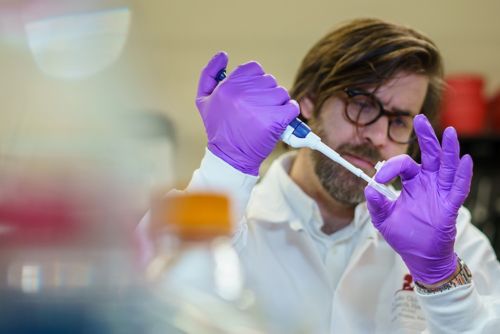St. Jude Family of Websites
Explore our cutting edge research, world-class patient care, career opportunities and more.
St. Jude Children's Research Hospital Home

- Fundraising
St. Jude Family of Websites
Explore our cutting edge research, world-class patient care, career opportunities and more.
St. Jude Children's Research Hospital Home

- Fundraising
Bryan Gibson Lab
Investigating how phase transitions guide higher-order genome structure and impact human disease
About the Gibson lab
Each of our cells produces a subset of genes crucial to cellular identity and functions. When genes are expressed incorrectly, this can result in disease. To understand the impact of gene expression in disease, our laboratory examines the processes that determine how our genetic material is packaged within a cell. We seek to understand how the composition of chromatin—a complex mixture of DNA, RNA, and proteins—controls the organization of chromosomes in cells. How chromosomes are organized can favor the production of certain genes over others, and we seek to understand why. Our insights will provide new opportunities to target incorrect gene expression in catastrophic diseases.

Our research summary
The human genome is rather large, yet it must fit inside small cells in a way that is amenable to regulation and gene expression. Our laboratory investigates the mechanisms that underlie the packaging of the genome. We use a variety of innovative approaches—biochemistry, genomics, cellular engineering, and advanced microscopy—to investigate how phase separation guides the higher-order structure of the genome.

Molecular Determinants of Chromatin Compartment Formation
Higher-order assemblies of molecules can phase-separate to create biomolecular condensates enriched with specific components and spatially localized cellular processes. Our laboratory has found that nucleosome arrays with euchromatin or heterochromatin features can phase separate to form distinct condensates, mimicking the segregation of these compartments in cells. Driven by this discovery, we explore the hypothesis that differences in chromatin composition trigger phase transitions that package the genome into discrete and different compartments.
To this end, we build chromatin condensates in vitro to understand the molecular basis of their formation. By creating different kinds of chromatin condensates, we can better understand their physical properties and functions and leverage this knowledge to make predictive manipulations inside cells. These manipulations help us probe how chromatin-driven phase transitions contribute to spatial organization of the genome and regulate DNA-templated biochemistry.

Functional Attunement to Compartment Construction
The molecules and interactions that constitute biomolecular condensates tune their material properties—some are highly dynamic fluids while others are more rigid or slow moving—and these differences can affect their biochemistry. As processes engage with the genome it undergoes morphological transformations, forming different materials that fit to their function. Our laboratory also explores whether these material states arise because of chromatin condensation and whether biochemical processes within them are tailored to the specificities of their construction.
By examining these processes, we hope to offer new insights that will shape a deeper understanding of how pediatric catastrophic disease originates.
Publications
Contact us
Bryan Gibson, PhD
Assistant Member
Department of Cell and Molecular Biology
MS 4422
St. Jude Children's Research Hospital
Follow Us

Memphis, TN, 38105-3678 USA GET DIRECTIONS